Saigon Attractions #8 The Reunification Palace
The Reunification Palace has seen quite a history. The French invaded Vietnam in 1858 beginning their assault, with the attack on Da Nang. By 1867 the colonisation of southern Vietnam, Cochinchina, was complete. The following year the new Governor, Lagrandiere, inaugurating the building of a new palace to replace the old wooden structure. Building materials were imported from France. The Franco – Prussian War of 1870, held up proceedings and the new palace was not completed until 1873. Lagrandiere named it, The Norodom Palace, after the then King of Cambodia. It was used by all the following Governors of French Indochina for residential and official state purposes.
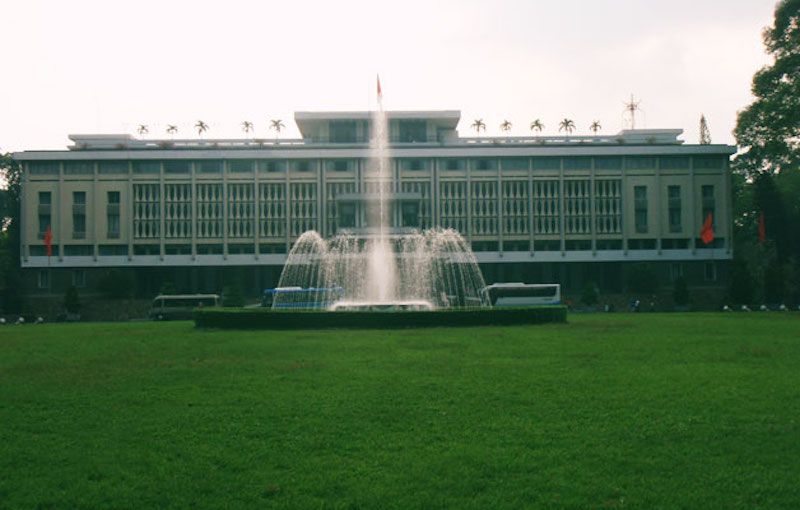
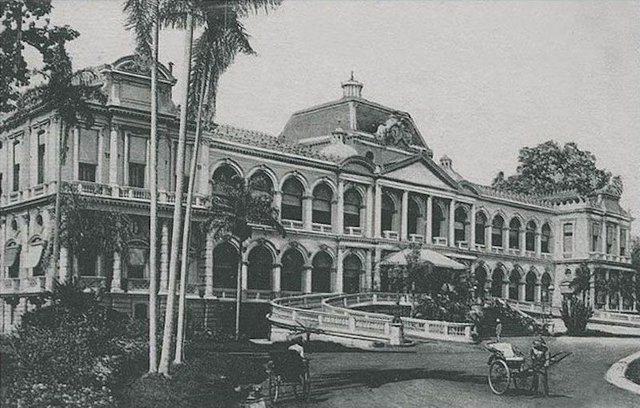
A great deal of the turmoil that Vietnam has witnessed, was visited upon the Palace. After the French were defeated in 1954, the 17th parallel was drawn as a buffer between the North and the South of the country. The communists in the North and the anti communists of the South were never going to get along. In 1955 a fraudulent referendum saw Ngo Dinh Diem installed as President of the South. He renamed the palace as The Independence Palace. The fighting between the two regions raged on. In 1962 as planes few towards Hanoi on a bombing run, two A-1, Skyraider aircraft broke formation and bombed the palace in an unsuccessful assassination attempt. Their bombs however destroyed the left wing of the palace. Diem escaped and ordered the badly damaged palace be demolished and a new one built in its place.
Historical witness
Diem was not to see the completely of his project as he, along with his brother, were assassinated during a coup d’état in November 1963. As the war with the communists in the north raged on two bombs again were to hit the palace at 10.45am on 8th April 1975, landing on the helipad, but causing only minimal damage. However, on April 30th just 3 weeks later, a tank burst through the gates and the fight against the north was lost. The war was ended and the event, known in the North as Victory over America, became known in the South as The Fall Of Saigon. After talks between the two sides were completed and the Provisional Revolutionary Government was installed, the place was renamed for a final time as The Reunification Palace.
It has become a symbol to the people of Vietnam and is one of the most visited locations in the country. It has been battered and bowed, but still stands proudly at the top of Le Duan, on Nam Ky Khoi Nghia, in District 1.
Taking a tour of the Reunification Palace
The palace is open to visitors daily between 7.45 and 11.00 every morning and 1.15 and 4.00 pm in the afternoon. Admission is a mere 30,000VND and you can take advantage of the free guide service in the reception area. This is definitely worth doing. When I went, I was the only English speaker there at that time, and I still got a guided tour. My guide, Hoa, was genuinely pleased to tell me all about each room as we moved through the palace.
After buying your ticket from the small sales office to the left of the main gates, you enter through one of the gates and can walk freely in the gardens. This is a large site, it covers some 18 hectares, about 44 acres. Directly in front of the palace is a beautifully manicured lawn with a large fountain. The reason for the placing of the fountain is to improve the Feng Shui. The tree-lined boulevard of Le Duan runs directly away from the centre of the palace in a straight line. Whilst to most this would seem to greatly enhance the appearance and status of the palace, It acts as an arrow, guiding bad luck and misfortune through the heart of the building. The placement of a water feature in its path, creates a harmonious and good luck bringing barrier.
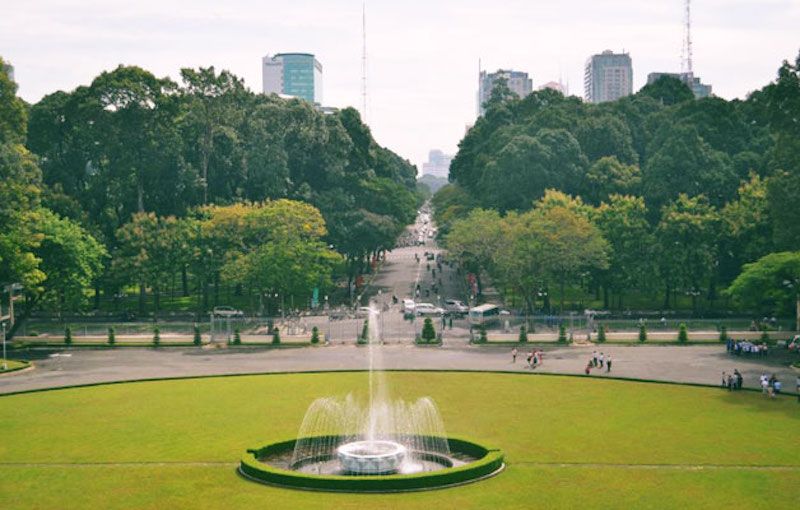
To the right hand side of the Reunification Palace, two tanks stand proudly displayed. These are of exactly the same type that burst through the gates on that fateful day in 1975. The scenes that must have greeted those inside the building on that day, as these metal monsters tore through the gardens, must have been terrifying.
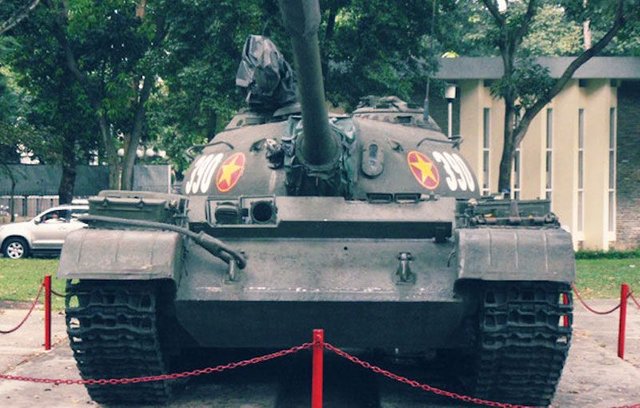
I moved on up the steps at the front of the building and into the reception hall. Asking about a tour in English, I was asked to wait and five or ten minutes later my delightful guide, Hoa, introduced herself. I was getting the five star solo tour, though I did draw strange looks as I posed to photograph the information boards that are outside every room.
We started with the Cabinet room where members of the government would sit and discuss the business of the day. It was strange to gaze at this room and wonder of history’s events.
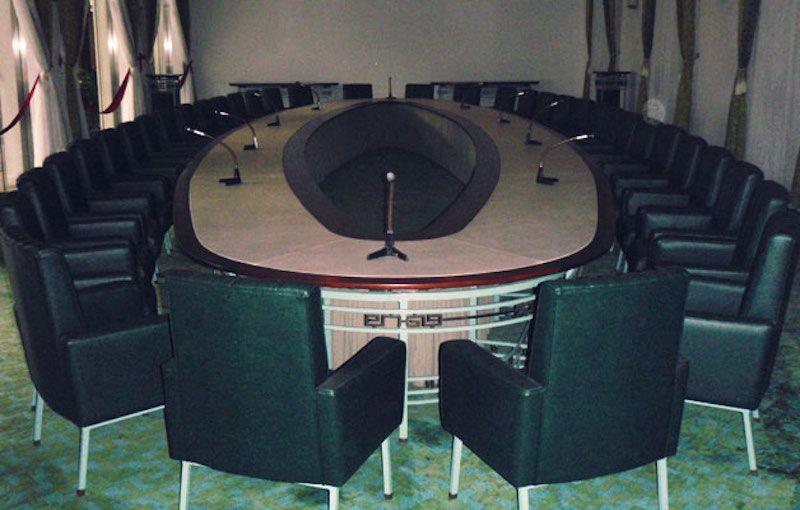
As you move from room to room it is easy to forget that this is still a working palace. Banquets are held here and visiting dignitaries are still entertained within these walls. That the whole building is open to the public comes as something of a surprise. The banquetting halls and reception rooms are beautifully furnished and decorated.
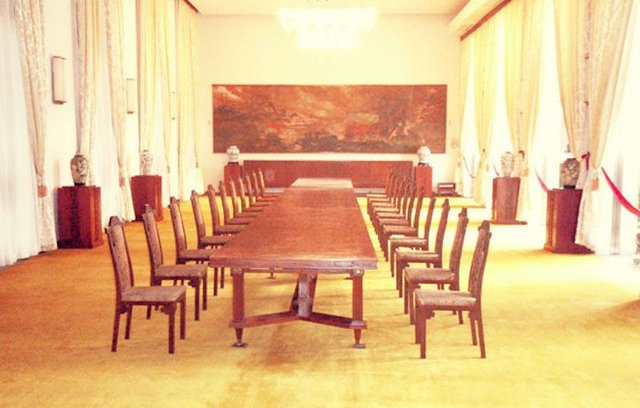
The Presidents office is suitably statesmanlike. With rich fittings and beautiful woodwork. Behind his desk is a large piece of wood which has been beautifully carved with three main stripes running down its length. This is to resemble the flag of South Vietnam. There is a padded metal door here, which is the escape route. From here the president could, in an emergency, descend straight through the heart of the Reunification Palace and into the underground bunker.
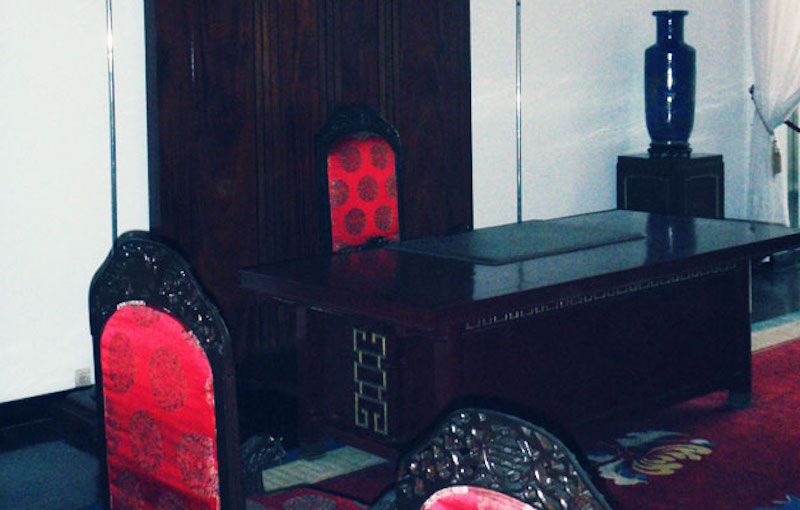
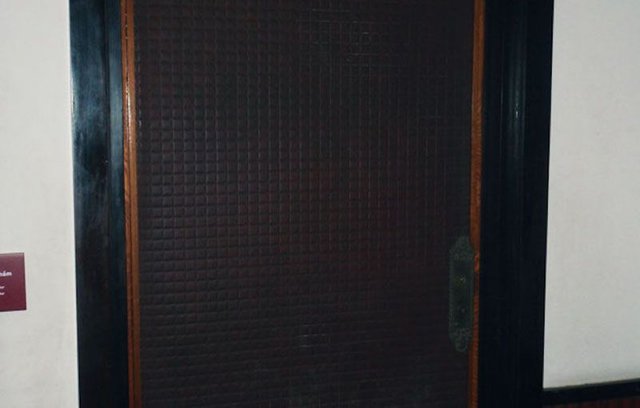
On the second floor (1st in England) the Presidents living areas are found. There is a central open courtyard here with a beautiful water feature. This place is especially tranquil and it’s hard to believe it is encased within the palace itself.
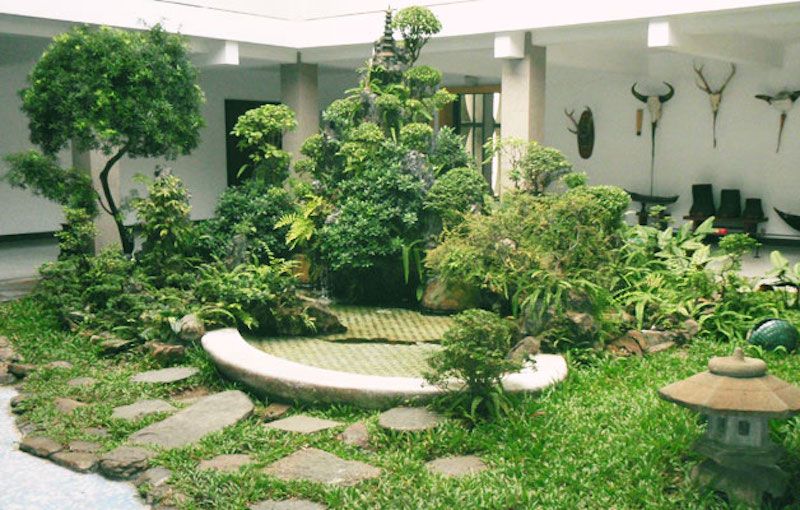
There is even a private cinema here with seating for about 50 people. It would be interesting to see the list of movies that the President showed to entertain his guests over the years. The projection room has equipment that seems so out of date today, but no doubt was state of the art when it was installed.
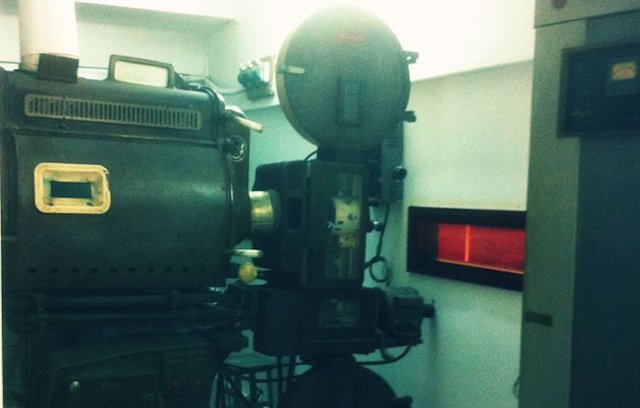
We continued on up on to the roof. The views from here are magnificent. When the Reunification Palace was built one would have been able to look right down the whole length of Le Duan. Nowadays however the trees that line this wonderful Boulevard, have grown to obscure that view. To the rear of the palace roof, on a lower tier stands the helicopter that was designed for emergency evacuation of the President. Such was the speed of the final day’s events, it still stands here unused. Two red circles mark the spot where the two bombs landed on 8th April 1975.
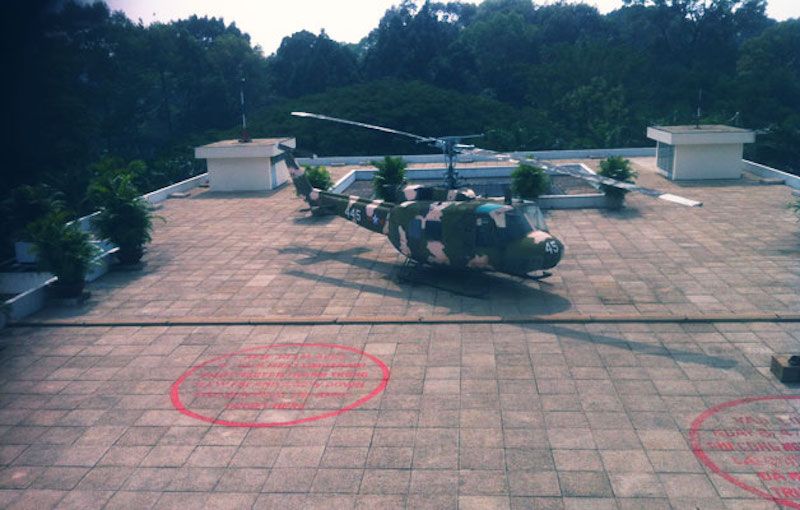
My lovely guide gave me time to stroll around and enjoy the views from the roof top. When I was ready we descended through the heart of the building and down into the basement. I have to say, for me this was the most interesting part. Two basement levels built to withstand bombs of 500Kg and 100Kg respectfully, were built here to protect the President and his generals as they planned their war with the Vietcong. American and Japanese made equipment, fills every room.
The President’s sleeping quarters here are extremely austere and not what you would expect for a President. The tour finished at a small cinema room where they show a film about the Reunification Palace. I wouldn’t really recommend this, I just sat through it for journalistic purposes. I certainly wouldn’t take children in. It is graphic in the nature of its content, including the scene of a Vietnamese man being executed by being shot in the head.
Summary
The tour is of course told from the point of view of the country’s leaders. This is only natural and whilst some complain that it is propaganda, I am not so naive to believe that everything we were fed from the American point of view, wasn’t simply the same.
I spent a good couple of hours at the Reunification Palace and thoroughly enjoyed it. Vietnam is a part of my life. The Vietnamese war was the backdrop to my youth and I would watch the news every night with my late father and marvel at this small country’s ability to fend off the Americans for such a long time. I have grown to love this country, very quickly. The strength of character of its people is self evident to everyone who cares to look. The Reunification Palace tells the story of where that strength of character comes from, quite adequately.
!steemitworldmap 10.777977 lat 106.695997 long The Reunification Palace D3SCR
For other Saigon attractions see also:
#1 Suoi Tien Theme Park https://steemit.com/travel/@inseasia/attractions-in-ho-chi-minh-city-suoi-tien-theme-park
#2 Vinh Nghiem pagodahttps://steemit.com/travel/@inseasia/saigon-attractions-vinh-nghiem-pagoda
#3 Notre Dame Basilica https://steemit.com/travel/@inseasia/saigon-s-magnificent-notre-dame-basilica
#4 The Cu Chi Tunnels https://steemit.com/travel/@inseasia/saigon-attractions-4-the-cu-chi-tunnels
#5 The Municipal Theatre of Ho Chi Minh City https://steemit.com/travel/@inseasia/saigon-attractions-5-the-municipal-theatre-of-ho-chi-minh-city
#6 People’s Committee Building https://steemit.com/travel/@inseasia/saigon-attractions-6-people-s-committee-building
#7 Museum of Vietnamese History https://steemit.com/travel/@inseasia/saigon-attractions-7-museum-of-vietnamese-history
I have been developing the InSeAsia website for three years. It genuinely is a labour of love. I have lived in Southeast Asia for 9 years and have no plans to ever leave.
I am extremely grateful to anyone who follows me, up votes, comments or re-steems my work.
Come and check me out. If ever you come to Saigon, Vietnam get in touch and we can meet up.
Website: http://www.inseasia.com
Steemit: https://steemit.com/@inseasia
Facebook: https://www.facebook.com/InSeAsia/
Facebook group for Southeast Asia Steemians: https://www.facebook.com/groups/846253152208905/
YouTube: https://www.youtube.com/channel/UC4YQUTrPwK190V4vbJDLt_A
Instagram: https://www.instagram.com/inseasia/
good blog
Thanks
A really beautiful presentation, nicely written and with many representative images!
Well done :)
Thank you @katerinaramm. I really do enjoy writing about Southeast Asia. Thanks for taking he the to comment.
I believe we were writing the first comments simultaneously!
You have a new insta-follower :)
Look forward to seeing more of your adventures and recommendations!
Thank you. This is still relatively new to me, but it's fun and it's growing. Excited.
This post has received a 0.62 % upvote from @buildawhale thanks to: @inseasia. Send at least 1 SBD to @buildawhale with a post link in the memo field for a portion of the next vote.
To support our daily curation initiative, please vote on my owner, @themarkymark, as a Steem Witness
Congratulations, Your Post Has Been Added To The Steemit Worldmap!
Author link: http://steemitworldmap.com?author=inseasia
Post link: http://steemitworldmap.com?post=saigon-attractions-8-the-reunification-palace
Want to have your post on the map too?
Add the following inside your post:
!steemitworldmap xxx lat yyy long description d3scr
(replace xxx and yyy with latitude and longitude)